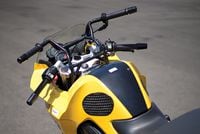Most barstool debates tend to devolve into generalities, opinions, and hearsay, in the absence of defined terms. Debating generalities just gives me a headache. The age-old countersteering versus body-steering argument—one of the oldest motorcycle-related barstool debates—is one that could especially benefit from some solid definition. Let's forget the "body" and "counter" qualifiers for a moment and just focus on the simple question of how to steer a motorcycle? Steering a motorcycle is the act of accurately and predictably guiding and directing an object toward or away from a known location in space. With that definition of steering in mind, let's investigate the common claim that bikes will "steer" with footpeg pressure alone, which is the basis of the body-steering claim.
Sir Isaac Newton’s third law of motion, often shortened to “for every action there is an equal and opposite reaction,” can be used to shed some light on the body-steering debate. This law is often misunderstood. It sounds like an object being pushed upon, like your footpeg or fuel tank, responds to the pressure by moving an equal amount. That isn’t what the third law means at all, however. What it actually means is that force always comes paired: There’s the force that is initiated; then there’s the resistance to that force.
Press on your desk with a force of 10 pounds; if the desk pushes back at you with a force of 10 pounds, nothing moves. The desk pushes back? Yes. You can say it resists your pressing, but in the end it is really just pressing back at you with an equal and opposite force. Are you getting a headache yet?
More examples might help: Picture sitting in a rocking chair. If you press your foot on one of the rocker tips, what happens? Not much. Sit in your car and press on the dashboard. Will the car move forward? Pressing on the footpegs or the tank of your bike has the same effect. These parts will resist, in an equal and opposing direction, any force you apply to them. The tank might cave in or the pegs might bend, but the bike will not steer.
On the other hand, if you shift or throw your body mass forward and backward in a rocking chair, the chair will begin to rock. You create an imbalance of forces, and the chair moves. Riding a bike no-handed is a similar phenomenon. Pressing one peg or the other creates a slight imbalance, and the bike compensates by tilting a little. The tire rolls over onto a smaller diameter, and the bike will begin to arc slightly.
Peg weighting can account for, generously, perhaps 1 or 2 percent of steering. Do it if you wish, but understand that without the countersteering inputs at the handlebars, a bike will not weave through cones at 15 mph, carve precise lines at speed, avoid a pothole, or enter your driveway. It isn’t steering.
Countersteering isn’t rocket science. Press the right bar and the bike leans and turns right; the more you press, the more it leans and turns. Conversely, stop pressing and the bike stops leaning any farther. It’s quick and easy to teach, it works 100 percent of the time, and it performs brilliantly by our previously established definition of steering. Most of us, unaware at the time, learn countersteering by riding a bicycle. Once an action is committed to so-called muscle memory, it remains there, uninspected. We do it without even thinking about it.
If weighting pegs makes you feel more connected to the bike, that’s fine, but understand that the minor, 2-percent influence peg weighting contributes to steering cannot correct a bad line or save your bacon in the event of an emergency swerve. It’s in direct conflict with Newton’s laws of motion. And without these laws, motorcycles would never have been built, much less accurately steered around Laguna Seca or even to the corner store.











/cloudfront-us-east-1.images.arcpublishing.com/octane/FZXHNOQRNVA3BIDWAF46TSX6I4.jpg)
/cloudfront-us-east-1.images.arcpublishing.com/octane/JRSFLB2645FVNOQAZCKC5LNJY4.jpg)
/cloudfront-us-east-1.images.arcpublishing.com/octane/ITNLTIU5QZARHO733XP4EBTNVE.jpg)
/cloudfront-us-east-1.images.arcpublishing.com/octane/VZZXJQ6U3FESFPZCBVXKFSUG4A.jpg)
/cloudfront-us-east-1.images.arcpublishing.com/octane/QCZEPHQAMRHZPLHTDJBIJVWL3M.jpg)
/cloudfront-us-east-1.images.arcpublishing.com/octane/HXOUJXQWA5HBHGRO3EMJIGFMVI.jpg)

/cloudfront-us-east-1.images.arcpublishing.com/octane/3TIWWRV4JBBOLDVGRYECVVTA7Y.jpg)
/cloudfront-us-east-1.images.arcpublishing.com/octane/KIX5O23D5NAIBGFXBN3327DKZU.jpg)
/cloudfront-us-east-1.images.arcpublishing.com/octane/7GJYDUIPXRGMTMQKN6ONYOLBOU.jpg)
/cloudfront-us-east-1.images.arcpublishing.com/octane/MUQLOVLL2ZDGFH25ILABNBXKTI.jpg)
/cloudfront-us-east-1.images.arcpublishing.com/octane/TNOU5DNE2BC57MFPMGN2EIDXAM.jpg)
/cloudfront-us-east-1.images.arcpublishing.com/octane/GTCXACQGJ5HAPDTGWUQKDEH44E.jpg)
/cloudfront-us-east-1.images.arcpublishing.com/octane/S35YGSEMEZB4BLTDJTSZPF4GLA.jpg)
/cloudfront-us-east-1.images.arcpublishing.com/octane/5UOT6HPX2JFMRJAX6EH45AR4MQ.jpg)
/cloudfront-us-east-1.images.arcpublishing.com/octane/OKWOJWAKP5EP3OACCRRWPCIX2Q.jpg)
/cloudfront-us-east-1.images.arcpublishing.com/octane/2WF3SCE3NFBQXLDNJM7KMXA45E.jpg)
/cloudfront-us-east-1.images.arcpublishing.com/octane/G4MG6OUCJNBSHIS2MVVOTPX65E.jpg)
/cloudfront-us-east-1.images.arcpublishing.com/octane/IIGGWFOTOJGB7DB6DGBXCCMTDY.jpg)
/cloudfront-us-east-1.images.arcpublishing.com/octane/QSTCM6AVEZA5JJBUXNIQ3DSOF4.jpg)
/cloudfront-us-east-1.images.arcpublishing.com/octane/U4I7G625B5DMLF2DVIJDFZVV6M.jpg)
/cloudfront-us-east-1.images.arcpublishing.com/octane/B6XD6LS6IVCQPIU6HXDJSM3FHY.jpg)
/cloudfront-us-east-1.images.arcpublishing.com/octane/ICL63FEDDRDTTMINYICCEYGMDA.jpg)
/cloudfront-us-east-1.images.arcpublishing.com/octane/FCGZHQXRBZFLBAPC5SDIQLVF4I.jpg)